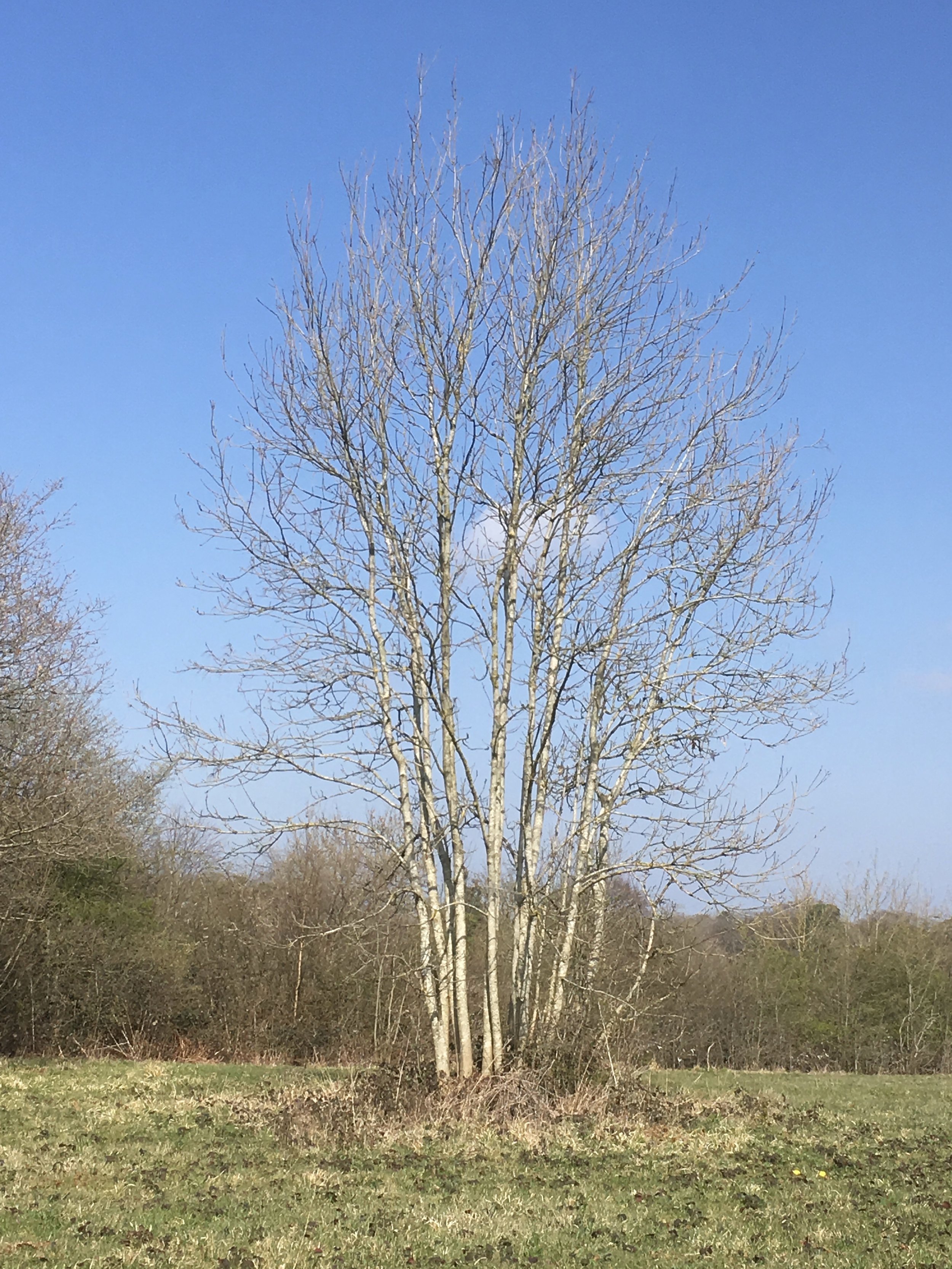‘Coppiced ash’ Ashton Court Estate, Bristol
Common ash (Fraxinus excelsior)
The ash tree is native to Europe and is the third most common tree in Britain. It is the last of our native species to produce leaves in spring and its beautiful airy foliage allows light to penetrate to the woodland floor encouraging woodland flora and fauna. There are invertebrates, lichens and mosses that depend wholly on the ash. Ash wood is very strong and flexible with straight grain and is used for furniture, joinery, tools and handles. Traditionally it was used for firewood and charcoal. Its burns for a long time with intense heat. Its twigs have a distinctive three pronged form like a trident, and black buds. In autumn, the clumps of seeds are know as ‘ash keys’.
Symbolism : Held sacred by Druids, the ash was used to make wands. In Norse mythology the ‘World Tree’ or 'Tree of Life’ was the ash. Its trunk reached up to the heavens, its branches spread over the earth and its roots down to the underworld, and their gods held their councils under its canopy. Viking ships, though made largely of oak, had all their symbolic parts made of ash. It is one of the traditional woods used as the Yule log. Gaels thought of the ash tree as protective, and it is often found near Irish hold wells. In Britain, ash was considered protective and healing, particularly with regard to child health.
Threats: Unfortunately, since 2012, ash dieback, a fungal disease, is causing ashes in Britain to lose their leaves and for the stems and turns to canker and crack. It is thought that tens of thousands of ash trees will die over the next decades, which will change our woodlands significantly.
About the tree:
Situated at the top of Ashton Court in Justin’s Meadow, I pass this tree regularly and was drawn to the lovely oval shape of its profile. Because ash trees are late to come into leaf, I was able to draw the form of its delicate network of branches over a period of three months of the spring of 2019. It was a lovely place to sit and draw: lots of birdlife and in May the wildflowers start to bloom. Unfortunately since then I’ve noticed its twigs are now starting show signs of ash dieback.
Trees like hazel and ash were traditionally cut back regularly to the base (known as the ‘stool’) to encourage new growth, which provided useful straight poles. This practice has been traced back to Neolithic times. Healthy ash trees can live to 400 years, but if coppiced they are maintained at the juvenile state and can live to immense ages. There are coppiced stools in Bradfield Wood in Suffolk that are thought to be 1000 years old. The age of the stool may be estimated from its diameter. A 2m ash stool has been estimated to be over 500 years old, so its interesting to think that this tree might not be as young as it looks! Coppiced shoots quickly regenerate with dense bushy growth, which provides cover for migrant songbirds, and the brambles that grow around the stools encourage insects and provide protection for small mammals.
About Justin’s Meadow:
In the beautiful grounds of Ashton Court Estate, this peaceful fenced area was re-named in memory of Justin Smith, a voluntary warden of this meadow and who over the many years recorded over 200 different species of fungi and 35 species of lichen here. I met Justin through my work at Avon Wildlife Trust. He was a brilliant mycologist, botanist, lichenologist and bryophyte specialist, and was known for his fun fungi forays and lichen walks. He had the wonderful ability to make lichens interesting and fun for all ages! His widow Lucy set up The Justin Smith Foundation which is committed to championing the forgotten kingdom of fungi, lichens and lower plants, providing workshops and and forays including to schools. https://justinsmithfoundation.org/ The meadow and the grassland surrounding it is also a haven of wildflowers including common knapweed, green-winged and common spotted orchids, wild carrot, bird’s-foot trefoil and meadow vetchling.
Directions:
GPS: ST 54409 72104
What3words: fees.issued.darker
For a hand drawn walking map click here:
Bike or walk:
From Bristol City Centre the National Cycle Route 33-Festival Way goes through the bottom of Ashton Court Estate. From here go up behind the mansion and follow the tarmac path through the parkland, taking the right hand fork, and go up the hill past the fallow deer park, past the warden’s house and to the top of the hill where it starts to level out and you will see a wide gravelled track on your left.
You can also cycle from Clifton over the Bristol suspension bridge and access Ashton Court via the Clifton Lodge Gatehouse (BS8 3PX). At the end of the drive, lined with beech trees, go straight ahead and as the path turns to the left there is a gravelled track on your right.
The gravelled track takes you up to the top of Ashton Court and at the far end you will find Justin’s Meadow on your left, surrounded by a wooden fence with gates at either end.
Bus:
Take X4 bus from the C7 city centre bus stop, to Clanage Road, Bower Ashton, and its a 10-minute walk past the UWE art college to Ashton Court Estate Mansion House. Or take the number 8 to Clifton and walk across the suspension bridge. Instructions are then the same as above.
Car:
Mansion house car park and Clifton Lodge car park open from 8am to dusk. Parking charges apply. Then instructions are the same as above.

